Related Research Articles

Guinea, officially the Republic of Guinea, is a west-coastal country in West Africa. Formerly known as French Guinea, the modern country is sometimes referred to as Guinea-Conakry to distinguish it from other countries with "Guinea" in the name and the eponymous region, such as Guinea-Bissau and Equatorial Guinea. Guinea has a population of 12.4 million and an area of 245,857 square kilometres (94,926 sq mi).

Papua New Guinea, officially the Independent State of Papua New Guinea, is a country in Oceania that occupies the eastern half of the island of New Guinea and its offshore islands in Melanesia, a region of the southwestern Pacific Ocean north of Australia. Its capital, located along its southeastern coast, is Port Moresby. The western half of New Guinea forms the Indonesian provinces of Papua and West Papua. It is the world's third largest island country with 462,840 km2 (178,700 sq mi).

The guinea pig or domestic guinea pig, also known as cavy or domestic cavy, is a species of rodent belonging to the family Caviidae and the genus Cavia. Despite their common name, guinea pigs are not native to Guinea, nor are they closely biologically related to pigs, and the origin of the name is still unclear. They originated in the Andes of South America. Studies based on biochemistry and hybridization suggest they are domesticated descendants of a closely related species of cavy, such as C. tschudii, and do not exist naturally in the wild. They were originally domesticated as livestock, for a source of meat, and continue to be consumed as food.
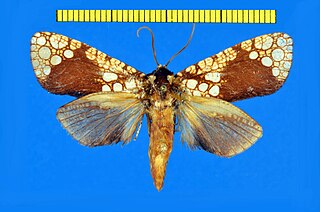
Dudgeonea is a small genus of moths and the only genus of its family, the Dudgeoneidae. It includes six species distributed sparsely across the Old World from Africa and Madagascar to Australia and New Guinea.
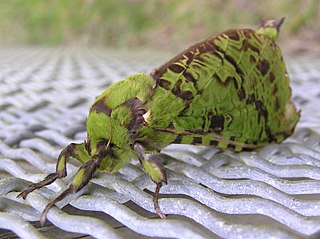
Aenetus is a genus of moths of the family Hepialidae. There are 24 described species found in Indonesia, New Guinea, New Caledonia, Australia and New Zealand. Most species have green or blue forewings and reddish hindwings, but some are predominantly brown or white. The larvae feed in the trunks of living trees, burrowing horizontally into the trunk, then vertically down.
Are is the second-person singular and plural forms of the verb "to be", the copula of the English language.

Breynia is a plant genus in the family Phyllanthaceae, first described in 1776. It is native to Southeast Asia, China, the Indian Subcontinent, Papuasia, Australia, and the island of Réunion.

Oxycanus is a genus of moths of the family Hepialidae. There are 71 described species found in Australia and New Guinea.
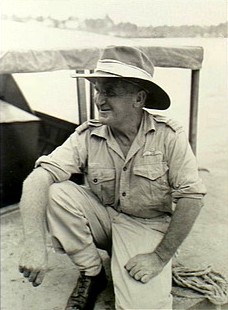
Alexander Augustus Norman Dudley "Jerry" Pentland, was an Australian fighter ace in World War I. Born in Maitland, New South Wales, he commenced service as a Lighthorseman with the Australian Imperial Force in 1915, and saw action at Gallipoli. He transferred to the Royal Flying Corps the following year, rising to captain. Credited with twenty-three aerial victories, Pentland became the fifth highest-scoring Australian ace of the war, after Robert Little, Stan Dallas, Harry Cobby and Roy King. He was awarded the Military Cross in January 1918 for "conspicuous gallantry and devotion to duty" on a mission attacking an aerodrome behind enemy lines, and the Distinguished Flying Cross that August for engaging four hostile aircraft single-handedly.
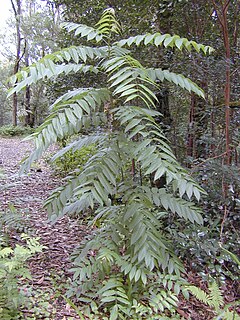
Toona ciliata is a forest tree in the mahogany family which grows throughout southern Asia from Afghanistan to Papua New Guinea and Australia. It is commonly known as the red cedar, toon or toona, Australian red cedar, Burma cedar, Indian cedar, Moulmein cedar or the Queensland red cedar. It is also known as Indian mahogany. Indigenous Australian names include Polai in the Illawarra. Woolia on the Richmond River, Mamin & Mugurpul near Brisbane, and Woota at Wide Bay.Also called Ai saria in Timor-Leste.

The de Havilland DH.61 Giant Moth was a 1920s British large single-engined biplane transport built by de Havilland at Stag Lane Aerodrome, Edgware. Intended primarily for use in Australia, a number were also shipped to Canada.

The Cape serotine is a species of vesper bat occurring in Sub-Saharan Africa. 'Serotine' is from Latin 'serotinus' meaning ‘of the evening'.
Sir George Hamilton Kenrick FRES was an English entomologist who specialised in Lepidoptera especially those of New Guinea. He was a prominent liberal educationist and was a councillor in Birmingham.

The following outline is provided as an overview of and topical guide to Guinea:

Lost Land of the Volcano is a three-part nature documentary series produced by the BBC Natural History Unit which follows a scientific expedition to the island of New Guinea. The expedition team, which includes specialist zoologists, explorers and the BBC crew, travels to the extinct volcano of Mount Bosavi in central Papua New Guinea to document the biodiversity of this little-visited area and search for new species. At the time of filming, logging was taking place about 20 miles (32 km) south from the volcano, and one of expedition's aims was to find evidence to support the case to protect the area. Some members of the expedition team travelled to the island of New Britain several hundred kilometres to the east to chart an unexplored cave system and observe an active volcano.

Neochera dominia is a species of moth in the family Erebidae. It is found from the Indo-Australian tropics from India to Queensland and the Solomons.
Asota heliconia is a moth in the family Erebidae. It is found from the Indo-Australian tropics east to Queensland and the Solomons.
Herculia is a genus of moths belonging to the family Pyralidae. The genus is mostly treated as a synonym of Hypsopygia. If considered valid, some species previously placed here are now in Dolichomia and Ocrasa, which in turn are also mostly merged in Hypsopygia. O. fulvocilialis is sometimes still placed in the present genus.
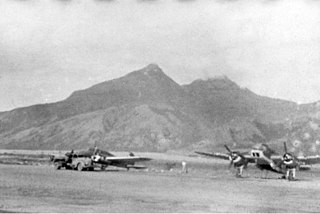
The Rescue and Communication Squadron was a Royal Australian Air Force (RAAF) squadron formed during World War II. Raised for service during the New Guinea campaign, the squadron existed between October 1942 and November 1943, and undertook a variety of support roles including search and rescue, transportation, reconnaissance and casualty evacuation. Upon disbandment, it was used to raise two new communications units.
References
- ↑ "AfroMoths". www.afromoths.net. Retrieved 2017-07-26.
| This Lithosiini-related article is a stub. You can help Wikipedia by expanding it. |